Photography as a necessary mean of investigation in a less strictly natural habitat. Pending from emotive to rational, from deliberately casual to precise indefinite. Attract attention to release it slowly. Moving on the edge of reality and its perception. Tell us in general about your field of research and about your education (use of medium format, time, waiting, studies…). What is indispensable, what is not?
Dieter De Lathauwer (DDL): I love reflecting on the work and images of others, and I wish I could define my own work in one catchphrase, but I cannot. I don’t think in black and white, I prefer putting things into question. If I would know what I was doing and why, the fun would be gone. Photography is the perfect way to put yourself in question. I love that feeling of uncertainty and discovery. I don’t tend to make photographic essays dissecting an explicit phenomenon in all its facets like a researcher or a ‘national geographist’. I tend more towards poetry: a concoction of images evoking certain feelings, thoughts and reflections. Creating something beautiful without the boundaries and rules of literature/photography. First I studied engineering, and afterwards I felt the urge to do something creative. This tension between emotion and ratio is my nature.

© Dieter De Lathauwer from the series 'Stilstand'
I have always had an interest in the combination of emotion with ratio. I love the work of Thomas Struth and Esser, but my heart really goes crazy when browsing through books from Larry Clark, Diane Arbus, Matt Mahurin or even the lesser known Chauncey Hare and Letizia Battaglia. That’s why I am also an absolute fan of Taryn Simon: she combines both a strong narrative with a strong yet dry imagery. Even though I am 32 right now, I only graduated as a photographer 5 years at the Academy of Arts in Ghent. Photography to me is a method, a means of spending time and forcing myself to look in a different way at the world around me. If you look around, people are ‘habit animals’. Everyday they do the same trip back and forth to work, people get accustomed very quickly by there surroundings, and they take their surroundings very quickly for granted. This habitualism often leads to absurd situations. I want to reflect on that. I want to reflect on people seeing things, while there brains filter all the stains away. Often I integrate bizarre objects creating a new harmonic image with a certain tension in it, but mostly based on traditional landscape paintings. I think that is what my motivation is: giving the spectator a new view on reality. For the time being that is by putting images against a wall, but I hope to extend that in the future by a more installation-like approach. The complementarities of sound/music and still image is very intriguing to me.
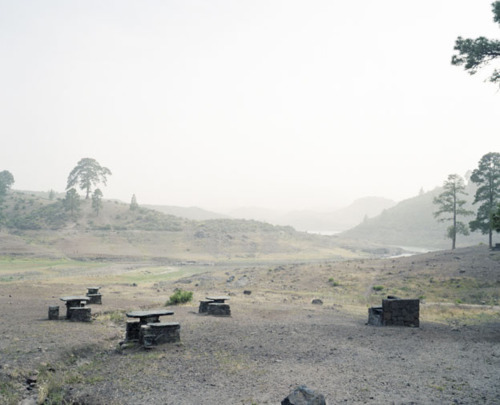
© Dieter De Lathauwer from the series 'Gc (Gran Canaria)'

© Dieter De Lathauwer from the series 'Gc (Gran Canaria)'
My series of ‘Gran Canaria’ is not showing the traditional postcard images and it does not show the happy fun sun sea sand side of the island. I could have made a Martin Parr-ish series: lightly mocking, flashy. I could have a made a “new topographers” view, very neutral and distant. Or I could have focused on the dirty backside. Instead I created another image of Gran Canaria, by transforming touristic places (beaches, holiday parks, swimming resorts …) into another world. In fact I have to continuously resist in making images! I have depicted these places with a certain distance, definitely with respect, but also with mystery and love. To me it is the combination of deadpan photography with a narrative, emotional and subjective twist. This makes it appealing to me. Again, the paradox between emotions and distance. I can enjoy sitting on a roundabout watching people go by, focussed in their habits.
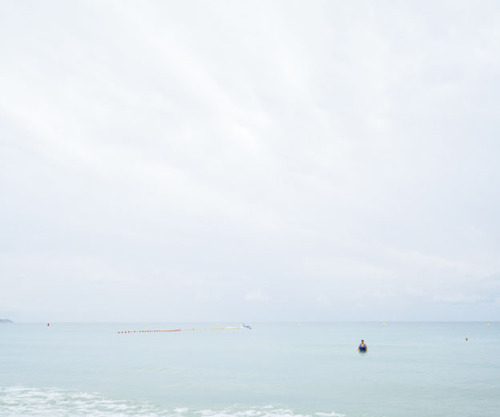
© Dieter De Lathauwer from the series 'Stilstand'
On the technical side I use a medium format camera, and recently I am experimenting with a large format camera. And even though my camera I use really feels like a natural third eye, equipment is not that important. Look at Stephen Gill, he can make wonderful images and books with a 6 dollar camera! Okay, I agree, I also adore the technical camera handling of Taryn Simon. She is together with Alec Soth my favourite photographer. But then again I hope to once make a book like Taiyo Onorato.
A tripod is indispensable. Photoshop is indispensable. The possibility to adapt colour contrast, to subtly play with shades of colour has been a real revolution. Printing in colour in the old days was a real pain in the ***. I loathed it. But thanks to the digital era we have the same and even more flexibility in colour images than we had in the dark room. I am quite a maniac when it comes to colour and the editing of an image. Not that I change a lot. I seldom delete things in my image. I almost never crop my images. But a tad bit of magenta and a little less sharpening can be such a big difference. For me at least.
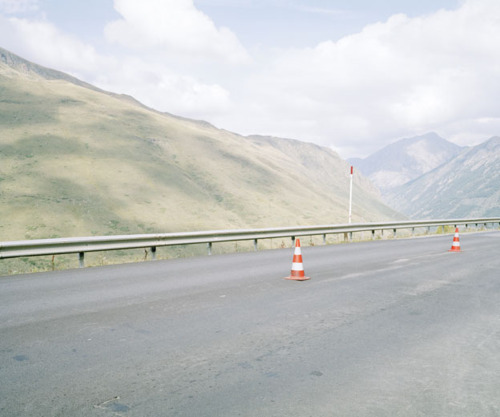
© Dieter De Lathauwer from the series 'Stilstand'
My own mood is indispensable. When making images I have to get rid as quickly as possible of my touristic mood, of my happy mood and of my rational mood. I have to replace it by an analytic, intuitive and slightly disappointed mood. I have to open myself up for those sudden moments of awareness. That’s why for my Berlin series I walked during the night, from 10pm until 4am: it gets me in a trance. And I enjoy the silence. The making of an image is only a tiny part of the whole process. You have the preparation part, and afterwards you have the most difficult part of letting the images rest, mature, selecting and rearranging them, reflecting on what I have done, getting lost in the wide range of possibilities to present your work, and finding a way to show what you have done to the public. Not to speak of finding the right place and the right people to show your work to the public. And last but not least my (spare) time is indispensable. Someone once said “everybody knows how to write, and (almost) everybody is capable of writing literature. But it is so damn hard to keep sitting at your desk day after day and not standing up to do other things.” It is the same with photography: the art is in the doing. And that keeps being a tough struggle.

© Dieter De Lathauwer from the series 'Stilstand'
Your projects take the form of inexhaustible proposals. Talks that should be left open. As if today it was no longer necessary to reach an answer; it is the vitality of the investigation that counts. This creates a silence, a breathing space for imagination. How do you prepare your projects? Do you choose the places or are the place to choose you?
DDL: If I decide to go somewhere, I always read about that place in advance; I buy maps, I love maps, I buy some more maps, I create a predetermined route, and I try finding geographically interesting pathways. I love borders: sea vs. land, water vs. mountains, national borders, rivers, highways. The interesting thing about a border is that is very often also a guiding line, a connecting line. Then I go there, and I end up not following my plans! How do I let go? No deadlines. No I have to be home for lunch, for dinner, for sleep. No worries. I think my images come to me. It is a matter of noticing them and of insisting in your intuition.
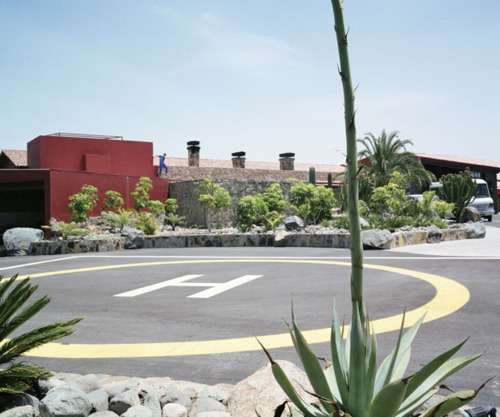
© Dieter De Lathauwer from the series 'Gc (Gran Canaria)'
I make my photographs in short intensive periods. Maximum two weeks. Mostly day and night. And then when I get back home the real work starts: creating a concise series of work (which might be small). My workflow is not “I go to Spain and I want to document, or portray, Spain”. My trip in Spain is merely a vehicle, a method to expose myself to influences. I set out axes, lines from A to B, I inform myself to know something more, I look out for the touristic places, and then try to modulate the world I encounter into my own personal world.
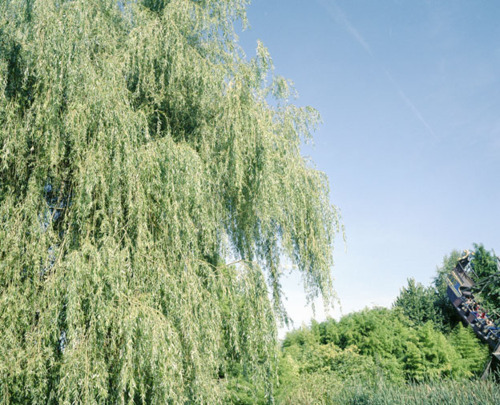
© Dieter De Lathauwer from the series 'Gc (Gran Canaria)'
The power of photography lies in the duality between reality and imagination. This seems obvious, but too often photography is too merely a reproduction of reality, both narrative (documentary) as displaying (dry realistic), or too anecdotically (the personal reminder). In a photograph, more than in a painting, reality is inherent. You need to use this to evoke a confrontation with the imagination, it should at least wring. Transforming the world. I’m a transformer, ha! A little bit of abstraction, but not too much. And I don’t like inventories, they tend to get boring. Unless they serve a higher goal, such as the Hong Kong or Japanese subway series of Michael Wolf. An inventory not as document, but as a means to create a more poetic whole. All respect for the Bechers, but it doesn’t touch me. Lovely works, but too cold. Even though they must have had a big love for what they are doing. I want to create space and possibility for subjectivity. Subjectivity is a mirror to introspection and identity.

© Dieter De Lathauwer from the series 'Gc (Gran Canaria)'
In your images the landscape appears as a pretext; far from traditional documentary intent or desire to depict its destiny. Your work seems fairly free from conclusions and presents itself as an opportunity for the viewer. Unfamiliar evidences and unusual surroundings that also cause some loss. Places are told with disenchantment and dusted by any rhetoric or iconographic vision. This is particularly evident in the work on the Wall of Berlin.
DDL: For my series 'The Death Strip', I visited Berlin a couple of times. In ‘The Death Strip’ my goal was to strip the Berlin wall from its touristic atmosphere, and give back a certain gloomy and threatening atmosphere to it. But you are correct: I am in search of silence. But silence only exists in the opposition to sounds. And even more important, photography is my way to put order in the chaotic world outside. My work starts from a documentary core, but I am convinced that this documentary core is not my ambition, not my objective. I take small series of images at a certain place, during a certain route. But I do not want to make a portrait of a place. My goal is not “look what is saw there” “look how ugly or beautiful it is there” “look how the local population struggles to survive due to our way of living”. What really interests me is the philosophical notion “I give you another world but don’t be mistaken it is the real world”. Of course all photography has an intrinsic documentary value.

© Dieter De Lathauwer from the series 'The Death Strip'
The place is part of my workflow. Most of the times I do not mention where the images are made. I have not yet decided if it is relevant or not. In the first part of my work (the small series) it is. But in the 2nd step, where I mix images from existing series and blend them together until it becomes another work, all factual information has become obsolete. Unless it serves to mislead the viewer. Oh well, all is still open and needs to be kept open. Good photography is a gateway to your imagenation, to your subconscious. Good photography gives you butterflies in your tummy and not just in your eyes.

© Dieter De Lathauwer from the series 'The Death Strip'
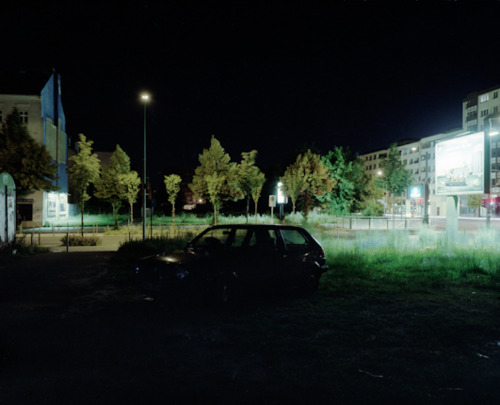
© Dieter De Lathauwer from the series 'The Death Strip'
Some images seem to find an expressive, as well as compositive, equilibrium with human presences or with their tracks. In others a scenographic intent is perceived; a need to create a scene or perhaps a conceptual situation. How do you relate to the people included through your camera?
DDL: People in my images are mostly like theatre props. They often are not the subject of the image (okay, sometimes they are), but are most of the time important. If the human presence would be obsolete or abundant, I would have either not included it, either I would have photoshopped away. Sometimes they are already in the landscape and there presence triggered my attraction. But sometimes I am touched by a scene, I feel something is missing in the composition (a colour, a counterbalance, ..) or in the content (a contrast, a measure, …). Then I wait. Sometimes hours. Seldom have I had a feeling of relation with the persons in my pictures. Which might be not true.
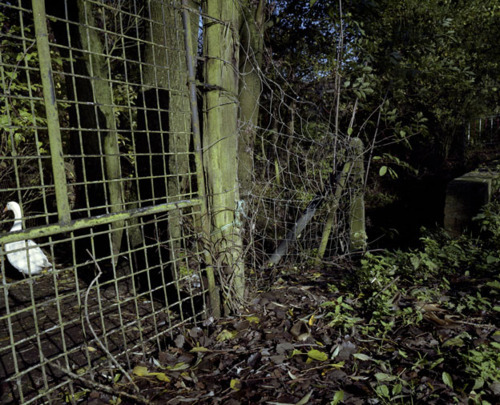
© Dieter De Lathauwer from the series 'The Death Strip'
My pictures are about the world around us, and how each individual relates to that world. It does not want to say something about that person. In fact we are all selfish individuals, thinking and pretending we are free but acting like cows and hurdles, without respect for the world we live in and without reflection on who we are, why we are here and what we could do with our lives. And everybody is thinking he is so damn unique. Ha! I do not like this semi-psychological talk you often hear in art or in photography. I get so tired of reading for the n-th time “Her images are more than you they appear to be, they are an apparent senseless yet metaphoric symbol for her own life by showing the things no one can see”.

© Dieter De Lathauwer from the series 'The Death Strip'
I am not a professor or an expert and therefore what is in my images I leave it open to Art critics and experts to write texts about them. What am I doing, what am I photographing, what do I answer people who ask me?!! But then sometimes I realize it is not that important, as long as I am serious about what I am doing. And as long as I know that its not just snapshotting away. As long as my images remain a mystery for myself I am happy. As soon as I can easily and clearly say why I like one of my images and what it evokes, I think I will withdraw it from the public. It is that sense of mixed feelings and paradox. Everybody wants to ‘understand’ photographs and wants to know why an image is made and how it was made. All questions I try not to ask when meeting an artist whose work I really like. It is important to keep the mystery alive. Maybe it’s like a magician. Everybody loves magicians, and everybody wants to know his tricks. And once you know the trick, the fun is over. In fact, we love to be fooled.
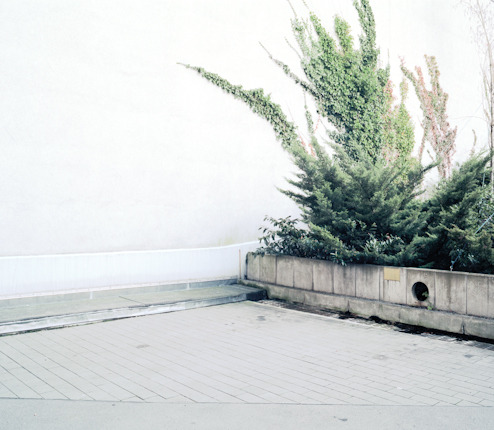
© Dieter De Lathauwer from the series 'The Death Strip'
The dialogue between comfort zones, memories, dreams one the one hand, and solitude, fear and death on the other hand are the core of my work. You mention that you get the impression that some of my images are put into scene. Yes and no. I try to create a new world with the world around me, with the simplest tools there are: light, colour, composition fed with my personal feelings. But in the end it all doesn’t matter a lot: colour, black’n’white, type of camera, subject, … What matters are the final images and its communication with the public. All the rest is secondary and that is the biggest struggle: the letting go, the not sticking to “it is good because of the light” but “I don’t know why, but I just like it and fuck all”. This struggle is continuous. Selecting images when I walk around, selecting images for publication. And again it is a paradox: I don’t think black and white, I like to reflect on things, philosophize, and that is the condition for me to make great images, but at the same time I have to make continuously choices: where do I go, when, what equipment, which images do I throw away, etc...
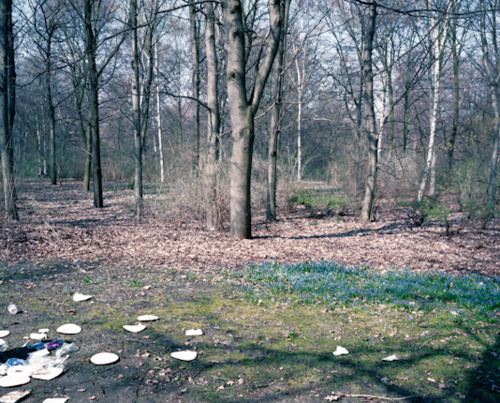
© Dieter De Lathauwer from the series 'The Death Strip'

© Dieter De Lathauwer from the series 'The Death Strip'
You recently had a solo exhibition 'Stilstand' in Bruges, Belgium. How do you rate this experience and how important it is for you to show the prints in public? Future ideas?
DDL: It was a great experience. Of course the exhibition in the museum of photography was also lovely, yet this show was the first time where everything fell in the right place: choice of images, prints, presentation, introduction by Karin Borghouts, a lot of visitors and a lot of positive reactions! The images were selected from different miniseries. And the final result expressed perfectly the feeling I to communicate. I chose not to print too big. Small size, but perfect print quality and top-level mounting. A combination of bare barite prints and prints mounted between plexi. The integration in the room you are working in is essential. It is more than just putting images against a wall. The exhibition should become a work on its own. An installation. Also here I see a lot of opportunities and ideas for the future. It was still a bit too “traditional”. But hey, I feel this is just the beginning!.
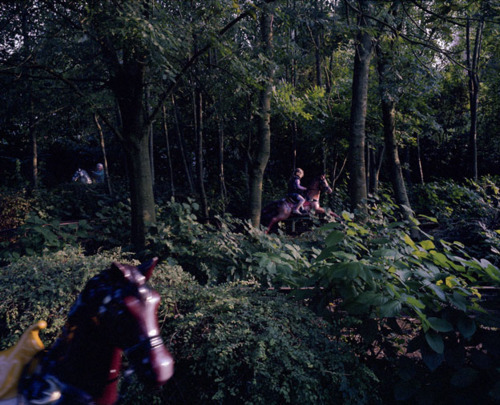
© Dieter De Lathauwer from the series 'The Death Strip'
And yes, 2010, was a successful year: the selection for the Canvas Price in the Museum of Fine Arts in Brussels, the exhibition in the Museum of Photography in Antwerp, a group show curated by the former director of the museum of photography and an exhibition ‘Fictive Landscapes’ in Brussels. And all of them without submitting any application. They all contacted me. I still can’t believe it! After three years of being active as a photographer that was quite a kick-start. In the meantime I made some first draft dummies of small photobooks. Books are important as they enhance the dialogue. Definitly as my images are ‘slow’, with a book people can enjoy it whenever they want. No, I don’t have a publisher (yet). A little box like the red one of Sophie Call would be quite cool. But a little bit bigger and a little bit more precious. And in 2010 I was invited to be part of a Belgian collective named Photolimits. Their group exhibition is running in June in Bruges (Belgium), where I show one completely new image of my new series “The decline of the gentle”. And now starts the search for the perfect exhibition place for this series! And I have started the preparation of a book of that same series! And I need to find budgeting! Ask me again next year what has become of it.
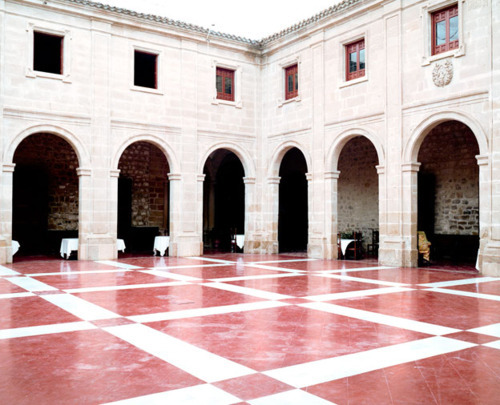
© Dieter De Lathauwer from the series 'Stilstand'
---
LINKS
Dieter De Lathauwer
Belgium
share this page